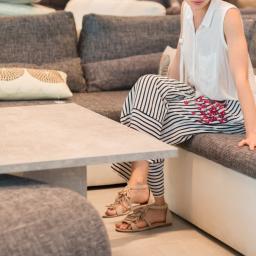Five Ways to Tell If a Couch or Sofa Will Be Comfortable Over the Long Haul

Buying furniture on your own can be stressful. Aside from the cost-if you're furnishing an entire two-bedroom house, that might run you close to $25,000 depending on your choices-there's the stress of choosing pieces that fit your aesthetic vibe, measuring to make sure they fit the rooms, and determining whether the stuff will last long enough to justify the investment.
And then there's what might be the most important factor: Comfort. Testing a piece of furniture for a few minutes in the store really doesn't tell you if you're going to love sitting on it for years to come, and nothing's more irritating than a couch or dining room chair that makes you unhappy, because that unhappiness bleeds into everything you're doing while using that furniture. While there are ways to improve the comfort level of a couch, ideally you shouldn't have to hack a brand new piece. The key is to use your time in the store wisely-here are five ways to tell if that furniture is going to be comfortable over the long haul.
Heavy items are usually sturdierTake advantage of being able to physically interact with a couch or chair by picking up the cushions and feeling their heft and weight. Generally speaking, the heavier and more substantial a cushion feels, the more comfortable it will be to sit on. Thicker, heavier cushions have more material to compress, and thus will distribute your weight more evenly, reducing the chance of pressure points that go from mildly annoying to excruciating surprisingly fast.
Pay attention to the firmness of the cushionsCushions can be softer or firmer, and the best choice is pretty personal. Some folks like a firm, unyielding cushion while others like to sink into a cloud. If you suffer from lower back pain, a firmer seat might be beneficial, but if you're buying a couch intended for use during cozy movie nights you might want a softer cushion. The key is to know your needs and how you'll use the piece, then seek out a cushion with the right squish factor.
Check the springsIf the furniture you're shopping for is upholstered and utilizes springs, research the type of springs used. The most comfortable choice will usually be eight-way hand tied coil springs, which are manually attached to the furniture frame and densely arranged for maximum support. Because they're labor-intensive, however, furniture made using these springs is usually the most expensive choice. If that's outside your price range, opt for sinuous no-sag springs (actually the most common springs you'll find in furniture), which use less material but offer decent support for comfortable use.
Evaluate the seat depth and heightA key aspect of comfort-and one that is difficult to appreciate in a few minutes of frenzied sitting in a store setting-is the height and depth of various components, especially when it comes to couches and sofas.
Seat depth (the distance from the front edge to the back cushion). The two things to consider here are your body and the intended use of the piece. Most sofas and couches have a seat depth between 20 and 25 inches, but deep-seat pieces can have seat depths as high as 35 inches. Generally speaking, the taller you are, the more seat depth you'll want.
An extra consideration here is whether you see yourself sleeping on the couch. For a single person, standard seat depth is probably workable (though more depth will be better for sleeping-consider that a twin bed is about 38 inches across). If you're going to be napping on the couch as often as you sit on it, deeper seats will be more comfortable overall.
Seat height (distance from floor to the top of the seat cushion). This is usually around 17 or 18 inches, but if the sofa or couch is very deep, a low seat height will make it more challenging to get up without feeling like you're climbing out of a soft hole. On the other hand, if you're tall, you might want a few extra inches of seat height.
Back height (distance from floor to top of back). Most couches and sofas will have a back that's 26 to 36 inches. Buying a sofa or couch because it's sleek and modern often means a lower back, but if comfort is your goal, you'll also need to consider how you like to sit. If you like to drape your arms over the back of the couch, choose a lower back height. If you want more back support, go higher-and the taller you are, the more inches you'll want.
One thing you can do in the store is get comfortable test how much work it takes to get up. If it's an effort in the store, it's not going to get magically easier at home.
Test out the fabricThe one thing most people do when furniture shopping is touch the stuff, so it might be obvious that you should make sure that any fabric covering your furniture is pleasant to touch. But the key is to really spend some time with it, because you will be touching it a lot when you get it home. If the fabric gives you a goose pimple" reaction when you touch it, or if it feels rough against your skin, or if you show any signs of an allergic reaction, ask yourself if you can live with that feeling every day for the foreseeable future.